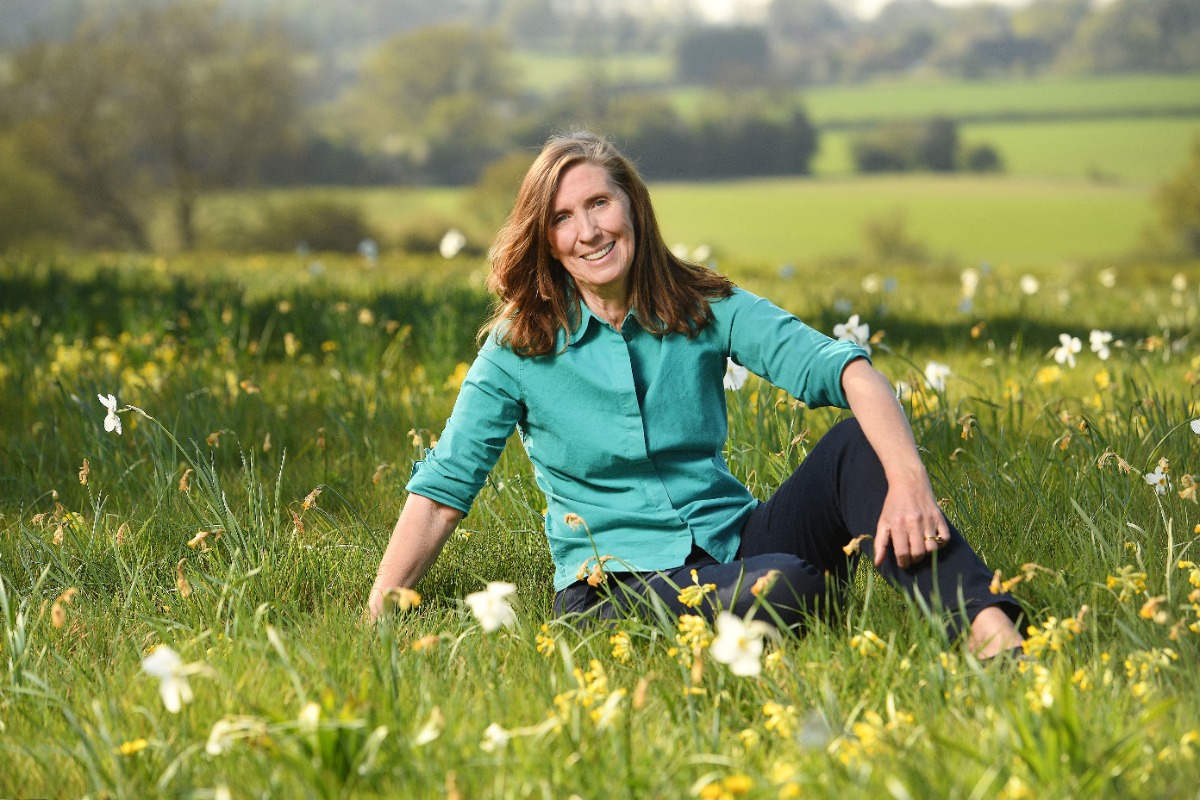
It’s good training for life if you garden
Una Meistere
An interview with Sue Stuart-Smith, psychiatrist, psychotherapist and author of The Well Gardened Mind
Sue Stuart-Smith is a British psychiatrist, psychotherapist and author of The Well Gardened Mind, a Sunday Times Bestseller that was listed as one of the 37 Best Books of 2020 by The Times as well as hailed Gardening Book of the Year by The Sunday Times. It has since been published in 17 countries, with the Latvian edition having come out this last summer.
In a powerful combination of contemporary neuroscience, psychoanalysis and brilliant storytelling,The Well Gardened Mind investigates the magic that many gardeners have known for years – working with nature can radically transform our health, wellbeing and confidence. Plants and gardening itself can indeed serve as some of our most insightful teachers. All that’s needed is time, attention, and inner silence to learn from them. Among other things, they can also teach us about the harmony, beauty, continuity of experience and cyclical nature of life.
Sue Stuart-Smith studied English Literature at the University of Cambridge before qualifying as a doctor and working in the National Health Service for many years, eventually becoming the lead clinician for psychotherapy in Hertfordshire. She currently teaches at the Tavistock and Portman NHS Foundation Trust in London and is a consultant at DocHealth, a not-for-profit psychotherapeutic consultation service for doctors.
Stuart-Smith has been married to the celebrated garden designer Tom Stuart-Smith for over thirty years now, and together they have created the wonderful Barn Garden in Hertfordshire. They recently launched The Serge Hill Project, a not-for-profit initiative based on the understanding that working with nature can radically transform people’s health and wellbeing. The aim of the project is to foster community inclusion through gardening and other forms of creativity, and to help people experience the mental and physical health and wellbeing benefits of gardens and gardening.
The Barn. Photo: Andrew Lawson
There’s a sentence in your book that resonated with me when I was thinking about our upcoming conversation today. You mentioned that if we look back in time, indigenous people made little distinction between caring for plants and caring for children. Taking this analogy deeper still, both plants and humans originate from a seed, and we require nurturing and care much like plant seeds do. In recent years, as we’ve grappled with pandemics and other challenges, including the harsh reality of war, there have been many discussions about plant consciousness and plant intelligence, and the need to rediscover this – to restore our lost relationship with the natural world. My initial question might be somewhat provocative: Have you ever considered how the idea for your book came to you? Was it entirely a product of your own thoughts, or do you believe that plant consciousness and intelligence might have played a role as well?
That’s really difficult to answer, I think. You know, we never truly understand the origins of our ideas. From a personal point of view, the book definitely represented a merging of various aspects of my life. My professional life as a psychiatrist and psychotherapist, managing a service in the NHS and then my life at home – my gardening life with my husband Tom. So, it felt like this was the right moment for all those parts to come together.
For me, there was something particularly significant – a form of synchrony that connects to my grandfather’s experiences. Even though I had been gardening with Tom for a while and had started growing food, I had not connected my gardening with my grandfather’s experiences. It was only when I prepared a talk for the Garden Museum literary festival in 2013 that that aspect of family history came back to my mind and I began to ask my mother more about it.
What strikes me about the timing is that I started writing the book around the 100th anniversary of the start of the First World War. My book was published in 2020, exactly 100 years after my grandfather began his horticultural rehabilitation in May 1920. So, throughout the time I was writing, I was acutely aware of the historical context and the lessons from that era. Of course, we couldn’t have foreseen that another war was on the horizon. So, that synchrony plays a vital role in the book’s genesis.
I can’t say for certain about plant intelligence but I do believe it exists in some form and I think we shouldn’t underestimate plants. However, it’s the historical aspect of the book that is of real significance to me.
The Serge Hill Project. Photo: Tom Stuart-Smith Ltd
We are deeply connected to plants through the web of life, of which we are also a part. There are numerous lessons we could learn from plants, but to receive these teachings, we need to embrace silence and find that in-between space to truly listen to them. It feels like we, as humans, may now be at that very point, ready to open ourselves to the wisdom of plants.
Yes, I completely agree with that. I believe it’s closely connected to another historical element. We have now reached a point where our lifestyles are incredibly unsustainable, given the climate crisis, loss of biodiversity, and so on. For generations and centuries, we’ve been out of touch as a species with our deep dependence on the natural world and our connection to it, not realizing that we are a part of it. I believe there’s a cyclic aspect to it; history often reveals that things follow cycles. So, in terms of the timing of the book, it is indeed highly relevant.
Another great lesson that plants are teaching us is that life will continue. We often think that everything relies solely on us humans, and that when we as species come to an end, nothing will remain. However, if you consider, for instance, the tragic incident at the Chernobyl nuclear power station many years ago, where everything in the surrounding region perished, plants have practically taken over now. Moreover, we are made up of atoms and even share DNA with plants, which means that when we pass away, our physical bodies may cease to exist, but a part of us may continue to thrive as a plant or perhaps even a bird. I believe this is a very, very important lesson that plants can impart to us, and in some way, we experienced it during the pandemic, when many of us reconnected with nature in a profound way. Perhaps plants can even help us find answers to some of our existential questions.
That was one of my deepest motivations for writing the book because I believe that working with the land, and tending to plants can address profound existential needs. I noticed that many accounts of how gardening helps people missed a crucial dimension. And as a psychoanalytic psychotherapist, I felt the unconscious element was missing. Much of the existing writing focused on the cognitive or mindful aspects of gardening and there’s a substantial body of scientific research on the stress-reducing effects of nature. All of these are undeniably significant. However, gardening involves a form of nonverbal communication and the symbols, metaphors and meaning we find in nature hold tremendous importance. I wanted to capture that depth of the experience.
It sometimes emerges when you engage in conversations with people about what gardening means to them. It’s clear that their feelings about their garden are deeply rooted, it’s a profound attachment. I felt this level of attachment was often missing in many of the existing books I read, especially when it came to explaining why gardening is healthy. My goal was to capture this essence.
To achieve this, I delved into my own experiences. I made an effort to capture them, which proved to be a fascinating exercise. Typically, we don’t take the time to do so, and why would we? It’s the experience itself that truly matters. However, I found that returning to the garden and writing about it was a genuinely gratifying process.
Delphiniums at the Barn Garden in Hertfordshire
But speaking of the writing process, where did you actually sit down to write? Did you write in the garden?
No, I wrote in an office in our outbuilding which has since been converted into my husband’s design studio because his practice has moved out of London. I am currently in my new writing room which used to be our youngest son’s bedroom. He is now an emergency medicine doctor working in London. While I was working on the book, I would often spend time making notes in the garden or finding inspiration in nature but when it came to proper composition, I needed to be in a more structured space. Sometimes I would sit in the garden and create a rough draft, but I always found myself returning to my desk for the final work. So, it was a balancing act that enabled me to draw on my experiences outside.
Photo: Jiaji Wu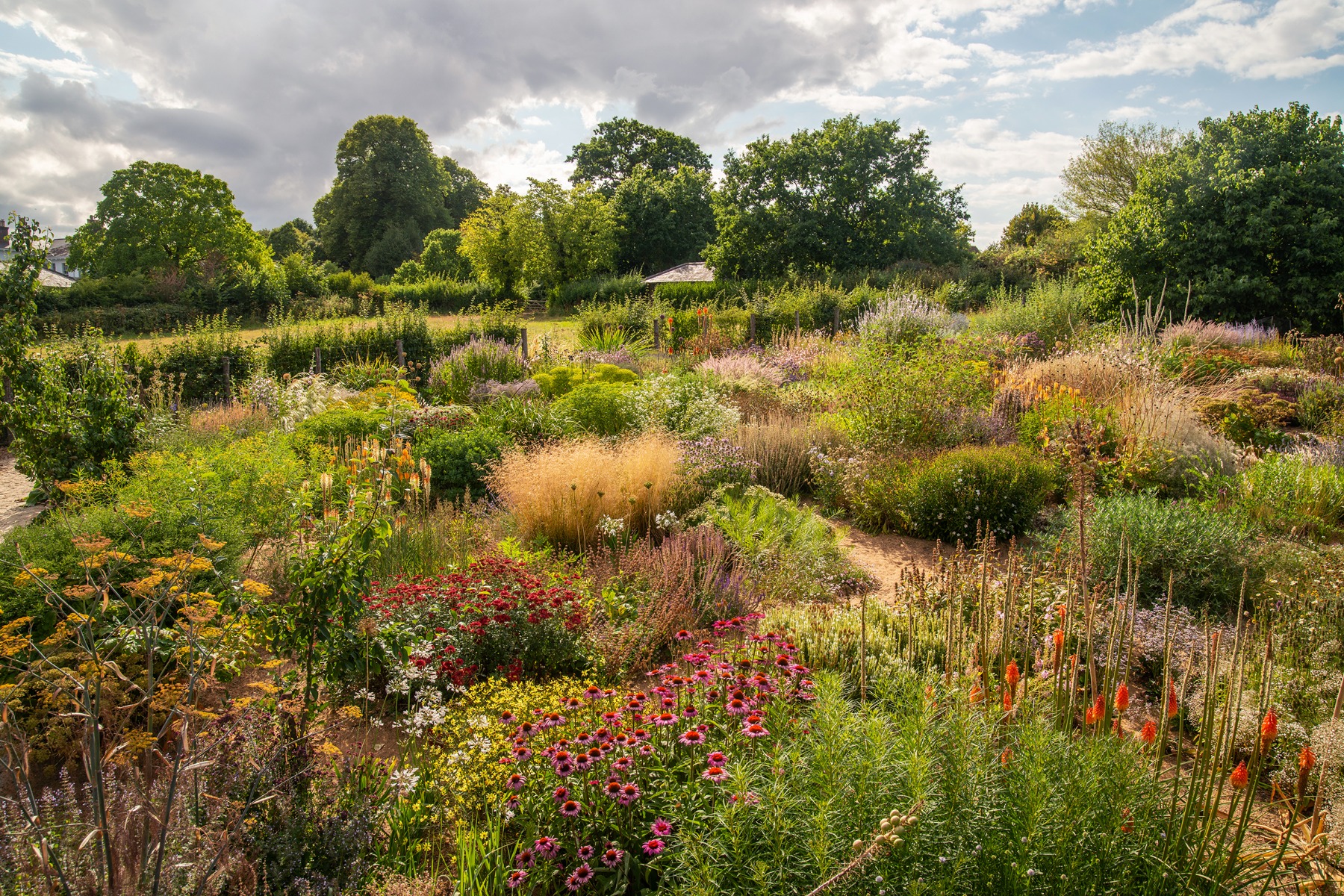
Gardening and the nature that surrounds us are significant sources of inspiration for creativity. This is supported by contemporary neuroscience research. What is your personal intuition on how this process occurs? How do plants inspire us creatively, and in what ways can they assist us in generating new ideas?
That’s another aspect of gardening that often goes underestimated. If you think about the range of creative therapeutic activities, gardening stands out as unique. While the arts can be therapeutic and significant in their own right, gardening offers a distinct experience. It’s not solely a product of human creativity; it’s a fusion of nature’s creativity with our own. It’s a living, dynamic relationship, and historically, this connection hasn’t always been appreciated. For too long, the focus has been on dominating, controlling, and exploiting nature. However, in reality, it’s a symbiotic relationship where these two forms of creativity come together.
For those who may feel uncertain or anxious about their creative abilities, gardening can be incredibly liberating. Unlike facing a blank sheet of paper with a paintbrush, which can be daunting, working in a garden harnesses the energy of nature’s growth. With relatively small interventions, you can get very significant and rewarding results.
Of course, things can go wrong, too. Pests, unpredictable weather, and various other factors can wreck your plans, but these challenges are also an integral part of the experience. It’s a learning process, one that teaches you how to deal with setbacks.
This union of nature’s creativity and human creativity holds significant value. It allows people to internalize something profound. When you work with the process of change and growth that gardening embodies, it’s as if you develop an intimate connection with these concepts. This closeness makes the idea of change and personal growth more attainable in your own life. Suddenly, it becomes a possibility.
I found that aspect of gardening came through really strongly in some of the interviews that I did, especially with the prisoners on Rikers Island. For almost all of them, it was the first time they felt a deep sense of pride in something they had accomplished. It was a tangible achievement they could look at and share with others. When someone said, “Wow, you grew that?” they felt a genuine sense of accomplishment. Of course, they understood that nature played a significant role, but still, they could say, “Yes, I did that,” and it meant a lot.
Whether it was the splendid chrysanthemums or impressive pumpkins or the delicious food they cultivated, they could share these with the staff and sell them outside the prison, so it’s a source of pleasure for others as well. Through this process, they internalized something important. It made them believe in the possibility of real change in a way they hadn’t before. So I feel working with nature’s creativity is empowering – it can make us much more creative.
Sue Stuart-Smith. Photo: Russell Sach
Also, there are moments when you find yourself stuck, wrestling with a problem, or in search of something new, and in those times, taking a walk in the forest can work wonders. As you meander through the woods, out of nowhere, a spark of inspiration can ignite your mind. It’s as if a brand-new idea emerges, and it has the power to entirely reshape your thinking and actions.
Absolutely, I believe that can indeed occur. As you may have gathered from reading my book, I am a firm believer not only in working within the garden but also in simply being with the garden. Whether it’s wandering through the garden or sitting quietly and becoming at one with it, there’s something transformative about the experience.
When we’re not solely focused on getting tasks done and allow ourselves to be immersed in the natural world, our minds enter a more integrated state. This integration allows us to access those thoughts and feelings that reside deep within us, as if we can listen to ourselves. When we begin to tune in to nature and establish a connection with it, our brains operate in a different, more holistic manner. This change in brain function can bring those thoughts and insights to the surface, and I believe this is of immense significance. In our fast-paced 21st-century lives, we often find ourselves fixated on screens and driven by productivity. We can easily lose touch with the entirety of our being. Yet, connecting with the fullness of nature provides an accessible path to experiencing the fullness of oneself.
Photo: Jiaji Wu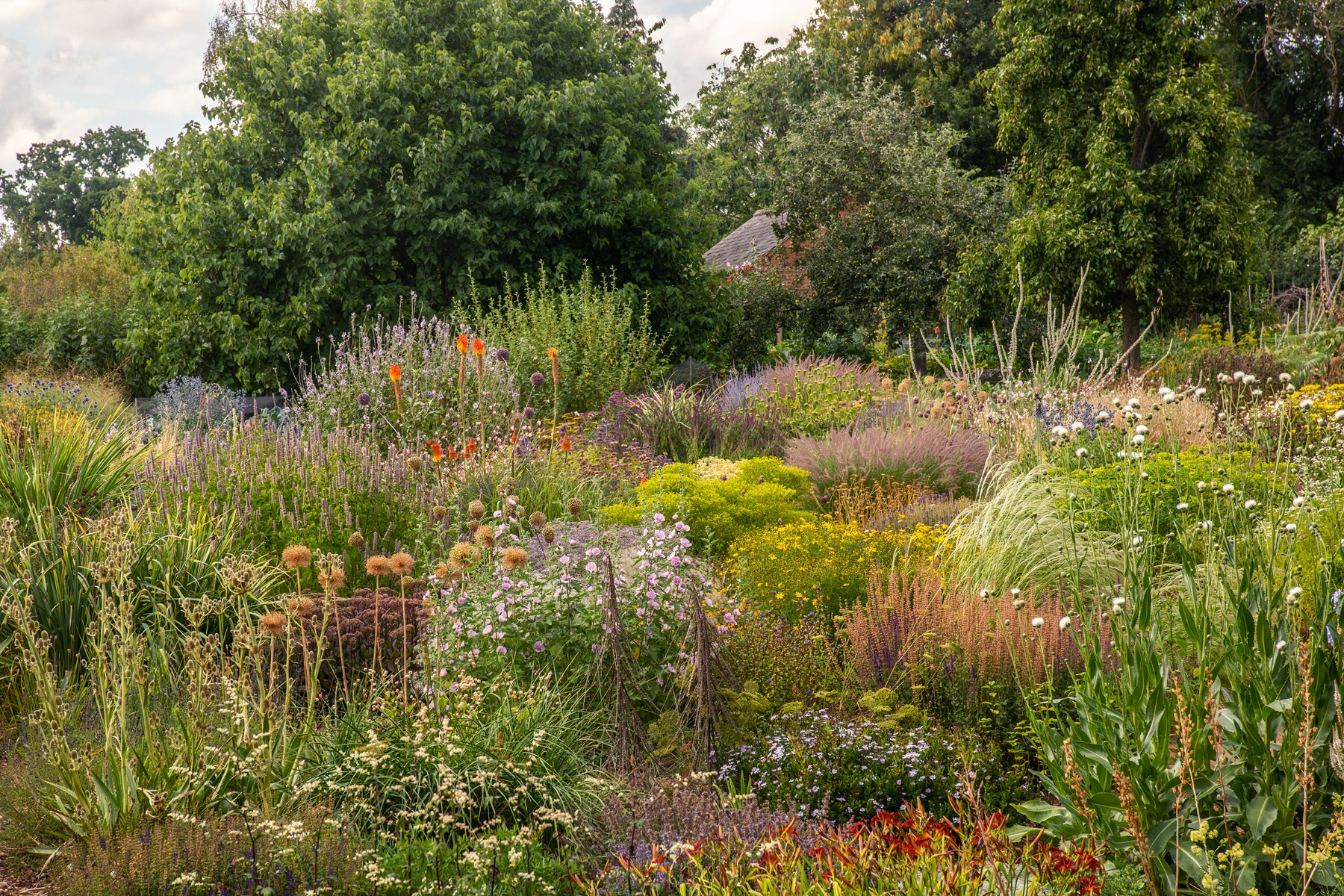
Otherwise, we have a kind of tunnel vision, and we’re limited by living in a box consisting of four walls. I also find it interesting that since we are used to communicating through language and words, many times disagreement can start because this or that particular word means something different to each of us. However, when you find yourself in nature, especially when you’re sitting in close proximity to plants, the mode of communication takes on an entirely different and purer dimension. It transcends the complexities of language and words, operating on a fundamentally profound level.
Absolutely; it’s incredibly vital for us to experience that, to reconnect with those aspects of our humanity that would have been more prominent in our hunter-gatherer ancestors’ lives. They lived in the natural world and communicated in various ways beyond interpersonal language. They understood the sounds of nature and their meanings, responding to them instinctively. They were fluent in the language of plants and patterns, and they could read the weather. We’ve lost touch with many of these sensory antennae that our remote forebears possessed in prehistory. So, we are only using one part of our human nature, in a way. In our modern lives, we often rely heavily on language and interpersonal communication, leaving behind a wealth of other ways to connect with our environment.
This relief from the constant demands of language and interpersonal communication can be very therapeutic. While our social connections and networks are undoubtedly crucial for our stability, they can also be the source of complexity and stress in our lives. Reconnecting with nature provides a valuable counterbalance.
I encountered similar sentiments repeatedly during my interviews with individuals involved in therapeutic gardening projects. One young man, who was on the path to recovery from psychosis, shared with me that he had grappled with a great deal of paranoia. He explained that he had found solace through his trust for plants, and this marked the beginning of his journey toward recovering a sense of trust in life.
Likewise, when I spoke with the prisoners at Rikers Island, many of them emphasized how much the experience of working with plants had helped them. In the garden, they felt a sense of acceptance – the plants couldn’t judge them, so they didn’t have to feel shame. They weren’t being perceived through the human lens, labeling them solely as prisoners. Gardening provided a transformative and therapeutic connection.
In my book, I refer to the pioneering work of Harold Searles, an American psychiatrist and psychoanalyst who was truly ahead of his time. He was writing in the 1960s and demonstrated a keen awareness of the ecological catastrophe looming on the horizon. Moreover, he astutely recognized the profound importance of trees to patients in the asylum where he practiced. Searles understood that people could experience a deep connection with trees, a connection that often eluded them in their human interactions. Whether due to their fragility or other factors, they were finding a sense of stability and solace through the simplicity of communion with trees.
It’s intriguing that I heard similar things from veterans recovering from PTSD. Trees have an enduring presence and provide us with a sense of security they provide when we are beneath their branches. For many of these veterans, trees served as an attachment figure, helping guide them back into the realm of life.
So I think we shouldn’t underestimate this whole other area of relating to nonhuman life. And of course, animals are part of that too – but we accept pets and their significance more readily. We give less recognition to the profound relationships that can be formed with plants, trees, gardens, and the broader natural world.
The other fascinating area I uncovered while researching the book was Freud’s passion for flowers. You can occasionally catch a glimpse of this in some of his texts, but it’s clear from his letters and the memoirs written about him that this was a constant theme throughout his life. For him, the beauty of flowers represented an expression of Eros – his concept of the life force itself. He held a profound passion for beauty, and this also manifested in his collection of antiquities.
Beauty, as Freud saw it, was not a superficial quality but a vital force, and I couldn’t agree more with that. It’s an aspect of our existence that we don’t always recognize or appreciate fully. Sometimes, it’s only when we are deprived of beauty in our surroundings that we realize its profound power and impact on our well-being and outlook on life.
Horatio's Garden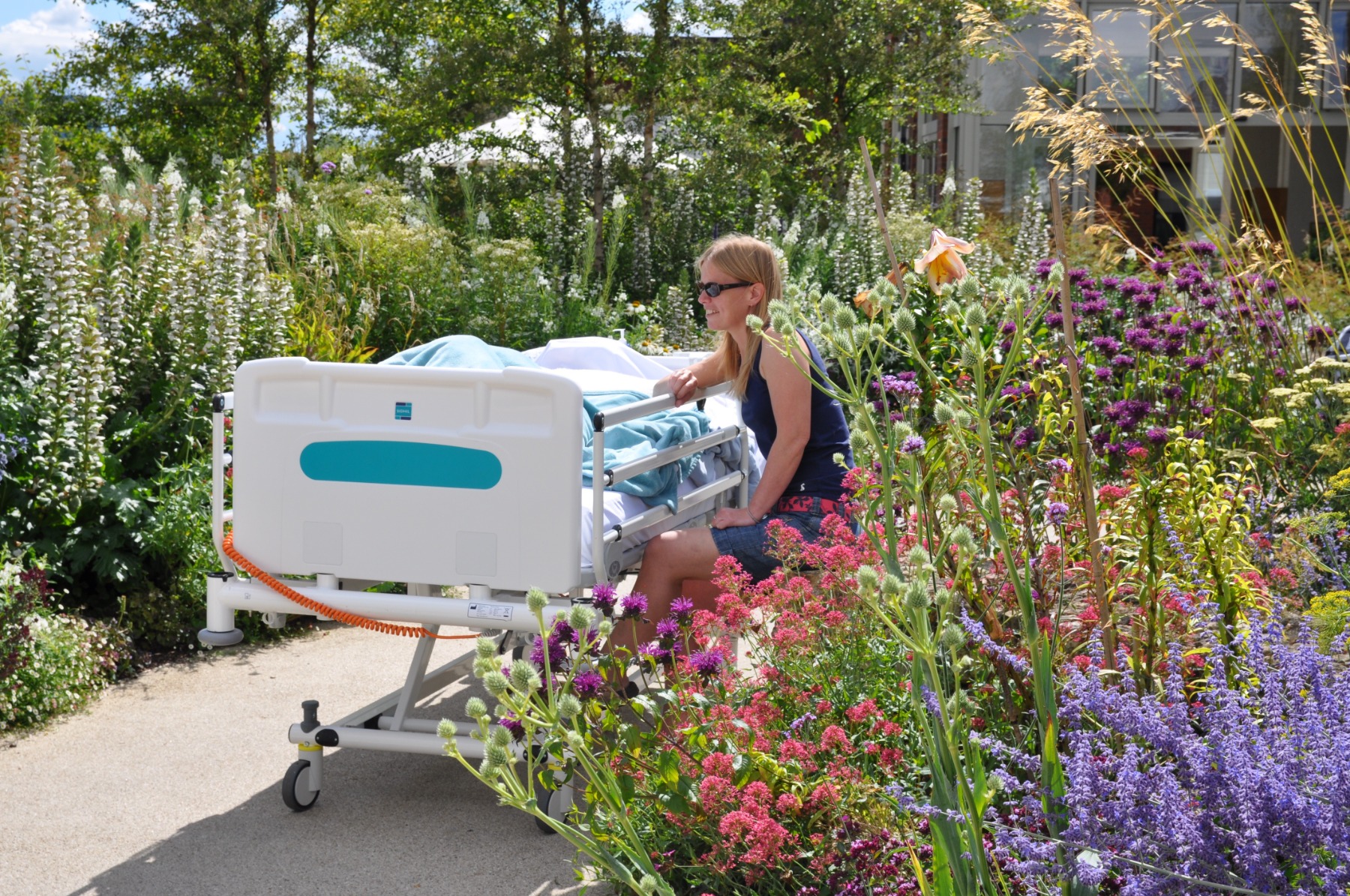
Towards the end of his life, Freud’s connection with nature and flowers became even more profoundly significant.
Yes, Freud became increasingly incapacitated during the last 16 years of his life after undergoing radical surgery on his jaw for cancer. While he continued to write and see patients, he ceased giving talks and lectures. As you’ll discover in the book, his love for hiking, collecting wildflower specimens, and foraging in the mountains was a lifelong passion. This was something he had engaged in since childhood, and he carried it through his life, sharing it with his children as they grew up.
Once he was unable to leave Vienna due to his doctors’ recommendations, he started renting villas with extensive gardens in the suburbs of the city from May to the end of September. He would see his patients there, and it’s evident from various accounts of his life that he had a ritual of walking around the garden every day, keenly observing all the changes taking place.
This aspect highlights how a garden can become an intimate space when it’s observed intensely. Many people who were fortunate enough to have a garden during the pandemic lockdowns actually experienced this for the first time. Typically, even if we have a garden, we aren’t home that much due to work or other commitments. However, people suddenly found themselves spending significantly more time in their gardens. Noticing the abundance of novelty and change in a garden is a remarkable experience – from the blossoming of flowers to the natural cycle of life and death. This close and firsthand experience allows us to witness the entire spectrum of life that a garden brings, from birth to decay, appreciating not just the flora but also the various other forms of life that the garden nurtures.
I have a friend who has a garden in London, and it’s a typical small London garden. She told me that she used to think her garden was very tiny. However, during the pandemic, she spent as much time as she could in it, tending it and paying close attention to its details. Surprisingly, it started to feel much larger to her. Paradoxically, as she delved deeper into her garden, she discovered much more within it, making it seem more expansive. This is why a garden can be so significant for people in hospital, or in a hospice at the end of life. Because the more we look, the more we see. A garden is a microcosm. It brings so much life to us and it changes us. It gives you so much if you take time to really experience it.
The Barn. Photo: Andrew Lawson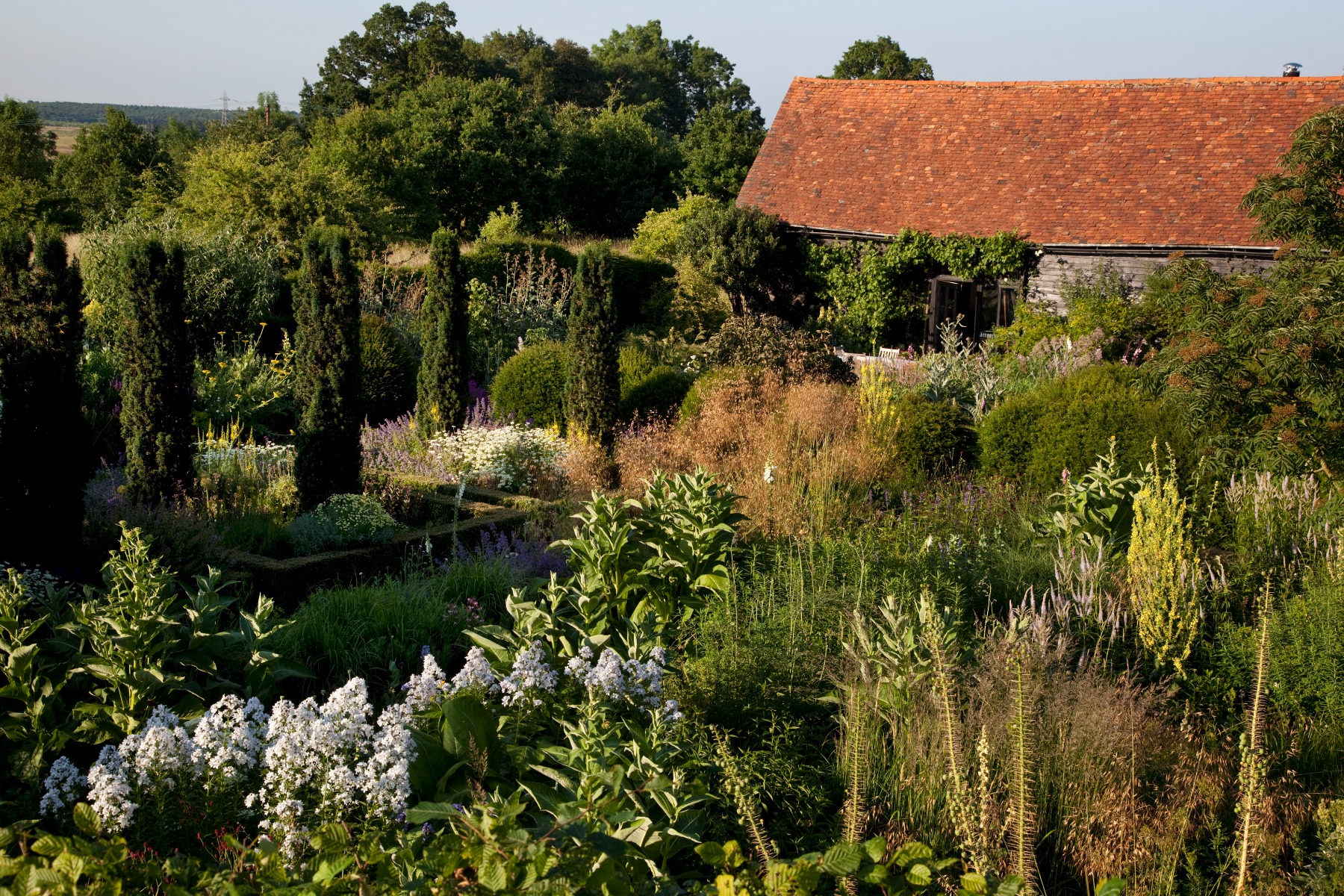
Certainly, and returning to what you said about trees, I believe there’s a valuable lesson we can glean from them – their robust root systems. Trees, as we know, are profoundly grounded. In contrast, many of us today tend to live predominantly within our heads, losing touch with this essential grounding. We often shy away from simple acts like going barefoot or connecting with the earth beneath us due to concerns about microbes and dirty feet, etc. Might trees, in their unwavering rootedness, serve as teachers showing us the way to become more firmly grounded?
Yes, I think roots are enormously important. And I think that was something else I felt in writing the book, in terms of human psychology – going back to attachment. Naturally, the bonds between a mother and child or within a family are profoundly foundational and influential. However, I felt that attachment to place had got totally sidelined. Yet that’s where we can establish our roots – by connecting to a place. It doesn’t necessarily mean being confined to one location, but rather identifying those places in our lives that hold deep personal meaning. It could be revisiting a particular spot in the forest regularly, somewhere that resonates with you and makes you feel grounded, almost as if you’ve metaphorically grown roots there. Because it’s a relationship over time. For trees, the root systems need to develop slowly.
This concept of attachment to a place seems increasingly important in our modern, mobile society. In our workplaces with practices like hot-desking, it can feel like everything is interchangeable. However, there’s an inherent, deep-rooted need within us to feel grounded somewhere. This need isn’t necessarily tied to staying in one place, especially for those who live in cities where constant moving is a reality. It could manifest in the form of a community garden or a special spot – somewhere you intimately know and form a personal bond with. Such a connection can provide immense stability during times of crisis. I believe that one of the costs of losing this attachment to place is the lack of a reliable anchor when our lives are suddenly disrupted. Having a significant place you can return to can offer great comfort.
Photo: Jiaji Wu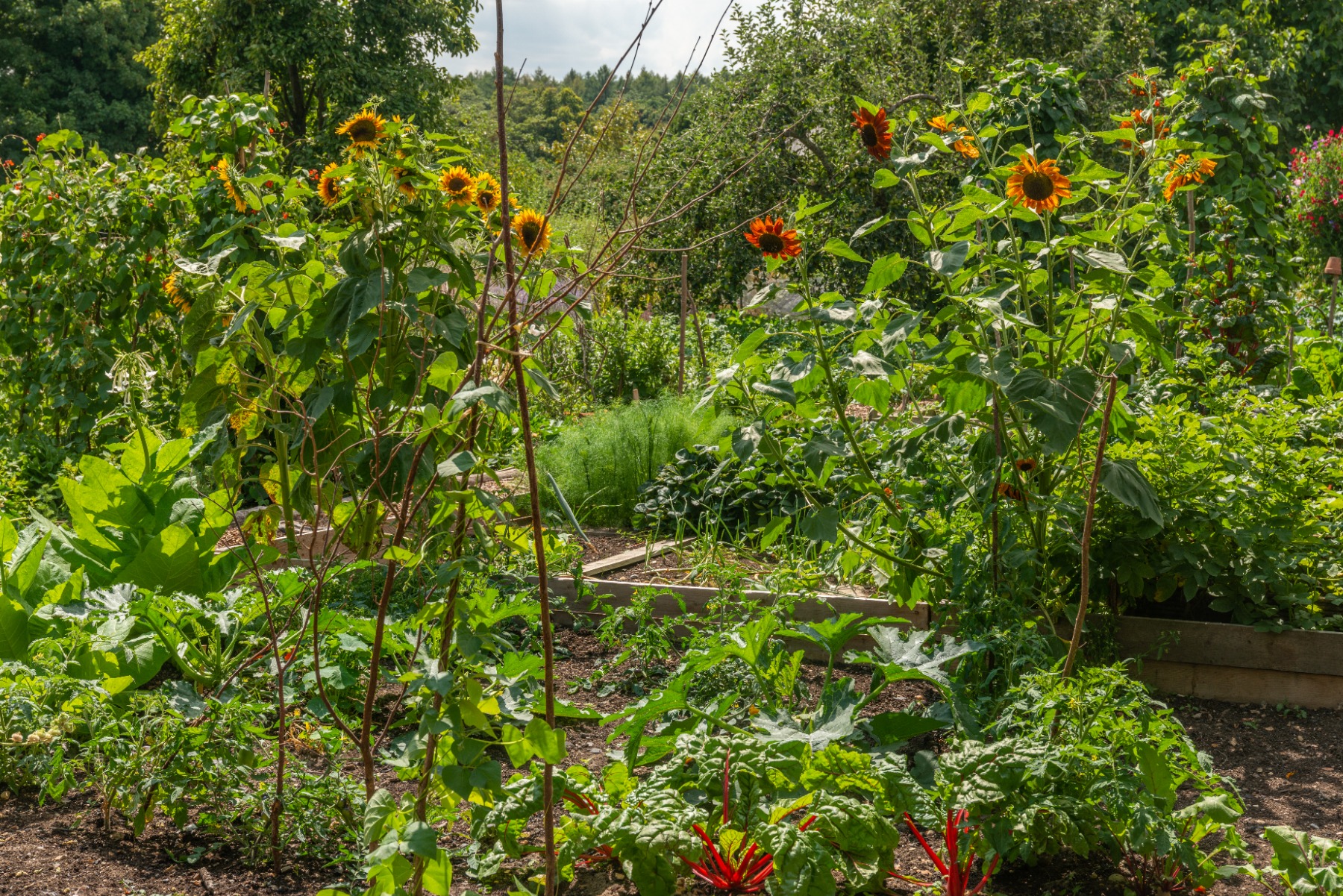
Speaking about cultural roots and a connection to the land, here in Latvia we’re proud of our strong sauna tradition, and those who hold onto ancient wisdom stress the importance of meticulously observing the garden encircling your home. This is because with each passing season, various plants draw nearer to your dwelling. When you take a closer look at these plant species and their inherent healing properties, you may indirectly find that they can resonate with your psychological or health issues.
I don’t think we should depend on the garden to diagnose our problems; I would suggest to go to the doctor (laughs).
Every spring when the first nettles come out, I make nettle soup. So yes, there is a lot that we can benefit from plants. My other favourite herbal plant is chamomile; I just love the smell of chamomile. I grow it in my garden and when I go out, I rub it a little bit; it’s such a wonderful smell.
I think these properties of plants are enormously important, and I want to emphasize the importance of scent, which we haven’t yet discussed. When you mentioned forests, it reminded me of some intriguing research on the phytochemicals found in plants and their impact on us. It is said that the pine scent can affect the immune system in a positive way. In a garden we might not necessarily experience the scent of pine, but there’s lavender, there’s chamomile, there’s all sorts of other scents like sage and rosemary. Rosemary is another favorite of mine. I believe these scents, along with the scents of summer and spring flowers, essentially constitute a language of their own.
The sense of smell is unique among our senses because our olfactory nerves communicate directly with the emotional and memory center in the brain, without first passing through other brain regions. This explains why scent has the remarkable ability to unlock powerful memories. In essence, the sense of smell communicates with us in a profoundly emotional manner.
For instance, consider the highly esteemed rose scent. If we look back through history, we find that the ancient Romans produced rose scent and rose oil in abundant quantities. This fragrance not only carries an inherent anti-stress and pleasure-inducing effect through release of certain neurotransmitters but also, intriguingly, it prolongs the activity of endorphins. In essence, the little endorphin rush you experience from the scent lingers for a more extended period.
In terms of truly comprehending the effects of the natural world on us, I believe we are still in the early stages of exploration. There is already some captivating scientific research, but there is a vast realm of knowledge yet to be uncovered.
Photo: Jiaji Wu
Touch is another fascinating aspect worth exploring. In Latvia, we have a special type of Artemisia called Artemisia abrotanum, known for its incredibly soft leaves. When you walk by it and gently touch its leaves, the sensation is truly remarkable, akin to touching a baby’s skin. It’s important to note that the texture of each plant species is unique and possesses the ability to evoke feelings and emotions, even enhancing one’s creativity.
Absolutely, when it comes to early life, smell plays a crucial role, with babies recognizing the scent of their mothers. Touch is equally significant during these formative stages. These two senses are of paramount importance.
Moreover, I believe that the use of our hands is often overlooked in contemporary lifestyles. Many of us spend our time holding our phones, making small movements with our fingers, without truly engaging with something tangible. This is a loss, considering that a substantial portion of our brain is dedicated to our hands. Our hands have played a pivotal role in our evolution, enabling us to be inventive, create tools, and accomplish so much more. Unfortunately, in 21st-century living, we often fail to utilize our hands in this way.
We are aware, based on educational research, of the significance of allowing children to interact with the physical world – as in the principles of Montessori education which emphasizes the necessity of tangible, hands-on experiences as opposed to engaging in virtual activities. This aspect holds immense importance for our mental well-being. When you can step back and observe the outcomes of your manual efforts, you have a tangible sense of accomplishment as opposed to something ephemeral, like a transient online task. This experience provides a boost in self-confidence and fosters a sense of self-reliance in individuals.
Interestingly, there’s a neuroscientist named Kelly Lambert who conducted experiments with rats. She designed an experiment that closely mimicked rats having to exert effort to obtain their food. Surprisingly, she discovered that the rats that had to actively seek out their sustenance using their paws were far less susceptible to stress compared to their counterparts who were simply provided with food without any effort on their part. Okay, we can’t assume it’s the same for humans but I think we can observe and feel the difference when we engage in such activities. There’s a distinct sense of accomplishment, and this concept isn’t limited to just gardening; it applies to various crafts and any pursuits where we can see concrete results created by our own hands. I think for many people it is missing. Interestingly, there seems to be a resurgence of interest in crafts, doesn’t there? It’s a recognition that this element is absent from many people’s lives, making hands-on creation all the more significant.
Photo: Jiaji Wu
Many of us, living in cities and often dealing with stress, are constantly seeking new ways to transition from our sympathetic nervous system to the parasympathetic nervous system. We turn to practices like meditation, attend yoga classes, and incorporate breathwork into our routines, sometimes overlooking the simple yet powerful remedy provided by green spaces within the city.
A brief period of immersion in a natural setting can indeed activate the parasympathetic nervous system, and some aspects of this effect manifest quite rapidly. For instance, within just three or four minutes, individuals experience a reduction in heart rate and a slight drop in blood pressure, as has been documented in numerous studies. The impact on the stress hormone cortisol, which is measurable through saliva, becomes evident after approximately 20 to 30 minutes. So, whether it’s a quick lunch break or half an hour at the end of the day, even taking just five minutes to step outdoors is still beneficial compared to not doing so at all.
I’ve noticed that in our words, we acknowledge that everything around us is constantly changing, and instability has become our new reality. Yet, we often yearn for stability. However, if we observe nature and our own gardens, we can see that they are in a perpetual state of change. Constant change is an inherent part of life. Perhaps this is what plants and gardening can teach us: to embrace this unstoppable change, even when it becomes turbulent, and learn how to navigate it.
Yes, I completely agree with that. I believe working with the cycle of life is one of the most powerful aspects of growing plants or simply spending time in the garden, witnessing those changes. There’s no denying that things die in a garden; we can’t escape that. However, you have the coming of spring to look forward to. It’s a combination of experiencing the transience of life on one hand and the continuity of life on the other. Experiencing these two aspects side by side can have a profound effect. It can aid in accepting loss and change. While it may not help everyone, I think it really can help and many people describe that. So, I think you’re absolutely right.
One of the themes in my book is the difference between cyclical time and linear time. Linear time can be challenging to live by all the time; it puts a lot of pressure on us, as if we’re on a conveyor belt, constantly moving forward. If you miss the moment, it’s gone forever, and if you miss an opportunity, that’s it. In the garden, you experience a different rhythm of life, one where you know that things will come around again. And if something doesn’t work out in a particular year, it doesn’t grow well, it’s not a catastrophe. Like, “I’ll try again next year.” Each year is different as well. We’ve experienced significant changes in our garden at home over the last few years. There was one year when all the tomatoes got blight because it rained all summer. I remember thinking, “Are we ever going to grow tomatoes again?” Yet, in the following years, we had two fantastic tomato harvests. You just keep on, keep on trying, and I believe gardening teaches you that endurance, in a positive way, because there are so many rewards as well as set backs.
Gardening is hard work and I don’t think we should underestimate that. I always tell people not to take on too much. Some people ask me after my talks, “But my garden causes me stress; it’s so much work.” That maybe because your garden is too big. You don’t need a huge garden to experience the effects I’m writing about. If you take on too much, of course it can become stressful. Perhaps it’s better to let some areas go a bit wild, which is also beneficial for biodiversity. We need to let go of the idea that gardens should always be neat and tidy because that’s not conducive to wildlife. In fact, it’s harmful to invertebrates if there isn’t enough broken wood and rotting debris for them to thrive on. It’s about adopting a different mindset toward gardening and accepting living with this endless cycle of change in nature.
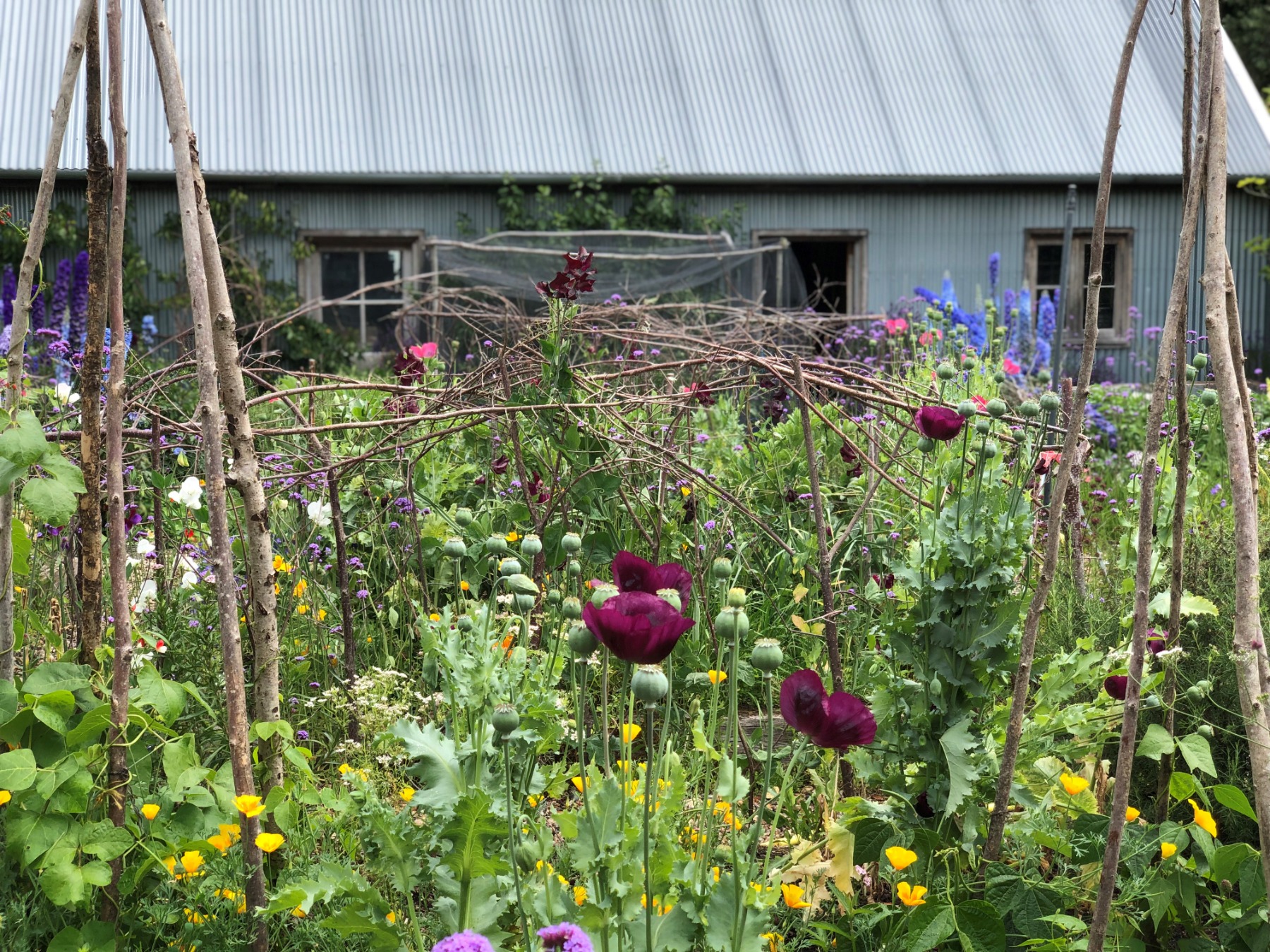
As you’ve already alluded to, every garden has weeds, and we, too, have our dark sides and shadows. Should we aim to eradicate those weeds in a garden and in ourselves, or should we simply accept them as integral parts of our garden and our beings? What lessons do the weeds in our lives offer?
I believe that in our lives, the idea that you could ever completely rid yourself of your metaphorical “weeds” is probably faulty thinking. Because, whatever demons we have, they tend to come back. So, there’s something about learning to live with them while also minimizing their destructive impact. I suppose that’s crucial. Often, the more aware we are of them, the less likely they are to sabotage us. There’s something about self-knowledge, which is fundamental. It involves an awareness of our weak points, our recurring patterns, and the traps we tend to fall into, often only to regret later. Triggers can activate these patterns, leading us to behave in ways we don’t really want to behave. So, yes, it’s essential to delve deeper into that self-awareness.
If you find yourself grappling with significant issues in this regard, formal psychotherapy may be the answer. It’s the only way to truly explore the labyrinth of your own mind because we all have blind spots when it comes to ourselves. Having a therapist to work with can be immensely helpful in this process. So I think there is a metaphor there about the garden of the mind and how we work on the garden of the mind.
I think, in terms of actual weeds in the garden, we’re becoming increasingly aware that having large areas of bare ground is detrimental to soil health and carbon capture. We need to be more tolerant of weeds. However, we don’t want them to overrun everything. My approach is to leave the weeds until they’re about to set seed, and then remove them to prevent them from taking over. So, it’s a balance.
In my vegetable garden, a variety of other plants thrive, some of which are self-seeded annual flowers that I absolutely adore. This not only benefits pollinators but also represents a significant step in letting go of the need for total control. Gardening, I believe, can serve as an antidote to perfectionism.
Sue Stuart-Smith. Photo: Harry Stuart-Smith
It’s hard training, but, you know, perfectionism seems to be on the rise. Of course, if you can’t let go of your perfectionism, gardening can really stress you out. But actually, if you learn to relate to the garden in a different way and understand that there’s a bit of a dialogue that’s going on – it’s not a spoken dialogue, but it’s like, I’ll do my little bit in the garden, and then nature will respond to that and come up with something else. And some of it is to be celebrated. You know, I love the fact that my poppy flowers, my calendula, my marigolds, and verbena – haven’t been planted for 20 years or more, but they keep coming up, and they are one of the things that make the garden most beautiful. I only remove them if I need a bit of space. So, it’s something to be celebrated – that the garden will give you back these things. When it comes to weeds, I just think you have to be judicious about it. This idea of having a perfect plot – nature’s not like that. I think it’s a real training for us in learning to live with nature, actually, and not imposing something. This sense of order – you can have a bit of order and a bit of chaos in the garden, and that’s healthy. That’s what life’s like, isn’t it? We can never control too much in life. You know, it’s good training for life if you garden.
Title image: Sue Stuart-Smith. Photo: Russell Sach